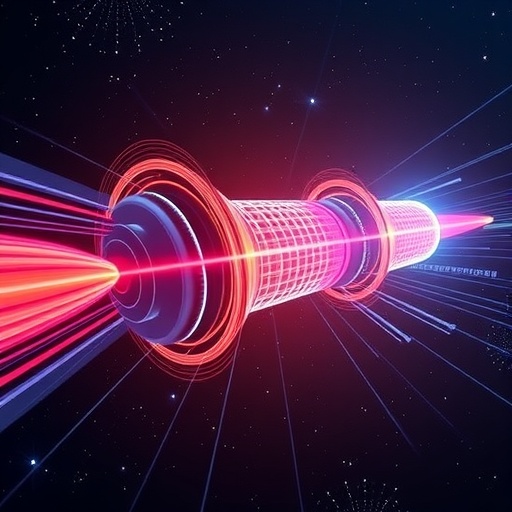In the ever-evolving landscape of astrophysics, one of the most groundbreaking advancements lies in the field of gravitational wave detection. The work spearheaded by Danilishin, Khalili, and Miao highlights the intersection of quantum mechanics and general relativity, offering profound insights into future gravitational wave detectors. Their research reflects a commitment to pushing the boundaries of what we know about the universe and transforming theoretical physics into practical applications that unlock cosmic mysteries.
Gravitational waves, ripples in the fabric of spacetime, are produced by some of the most energetic processes in the universe, such as colliding black holes and merging neutron stars. Since the first detection of these waves by the LIGO observatory in 2015, the field has burst into a new era of astronomy. With each event detected, our understanding of the universe expands, yet the quest to refine detection methodologies continues. The research by Danilishin and his collaborators addresses this necessity for improved sensitivity and specificity in gravitational wave detectors.
A central theme of their paper focuses on advanced quantum techniques that could significantly enhance the performance of gravitational wave observatories. Quantum mechanics plays a pivotal role here, particularly in managing the noise levels that traditionally plague detectors. For instance, the use of squeezed light techniques has emerged as a key strategy. By manipulating the quantum states of light, scientists can reduce uncertainty and improve the measurement precision, thereby allowing detectors to capture fainter signals that would otherwise go unnoticed.
One of the most exciting aspects of this research is its discussion of various noise sources and their implications for sensitivity. Quantum noise, which arises from the inherent uncertainty principle, can undermine the clarity of gravitational wave signals. However, the findings suggest innovative methods for circumventing these limitations. As the authors elaborate, specific configurations and setups in detectors can be optimized to combat such noise, thereby redefining our capabilities in gravitational wave astronomy.
In their investigation, Danilishin and his team also delve into the potential integration of quantum optomechanics into gravitational wave detection systems. This approach harnesses interactions between light and mechanical systems at the quantum level, allowing for remarkable sensitivity improvements. Through innovative design and calculation, these integrated systems could pave the way for the next generation of detectors, potentially tripling the reach for observing phenomena from the cosmos.
The practical implications of their research are immense. Not only does it inform future designs of gravitational wave observatories, like the anticipated LIGO upgrades, but it also underscores the necessity for transdisciplinary collaboration in modern-day research. As quantum physics and gravitational wave detection converge, physicists, engineers, and computer scientists must work in concert to realize these advancements. This collaborative spirit is essential to tackle the complexities presented by both fields.
Moreover, the collaboration doesn’t just stop at theoretical understanding; it extends into experimental realms where concepts can be tested and validated. Laboratory experiments are vital for ensuring that advancements can translate from mathematical models to real-world applications. The findings shed light on the importance of building prototypes and testing systems designed around these advanced quantum techniques, which could radically shift our capabilities within barely a decade.
As observers stand on the brink of a new realm of astronomy, one cannot overlook the philosophical implications of detecting gravitational waves with higher precision. Each detected signal opens a window to events that occurred billions of years ago, transforming our perception of time and history. The insights gained not only deepen our understanding of the universe’s architecture but also fuel our curiosity about the fundamental laws that govern motion, energy, and interaction at the most basic levels.
The future of gravitational wave astronomy may very well rely on a series of coordinated advancements as outlined by Danilishin and colleagues. Emphasizing that each breakthrough in detector technology must mirror advancements in quantum mechanics underscores a crucial point: our study of the universe is intimately tied to our grasp of the physics underlying it. Just as Einstein’s theories redefined gravity, today’s quantum techniques might just revolutionize our comprehension of cosmic events.
Furthermore, the implications of their findings stretch beyond gravitational waves. They resonate across several fields including cosmology, particle physics, and quantum computing. Each improvement in detection sensitivity potentially leads to new discoveries—things like dark matter, dark energy, and other forms of cosmic phenomena that challenge our current models. These discoveries can alter the course of established theories and open new avenues of inquiry, promising an exciting trajectory for future scientific exploration.
In concluding, the research conducted by Danilishin, Khalili, and Miao stands as a hallmark of modern physics. Their work exemplifies the essential convergence of disparate scientific domains—quantum physics and gravitational wave astrophysics. With their insights into advanced techniques, they not only illuminate the path forward for the ongoing quest of understanding the universe but also inspire future generations of scientists to explore the furthest bounds of physics. The era of discovering gravitational waves was just the beginning; with continued dedication to innovation and collaboration, who knows what further revelations await us in the cosmic dance of the universe?
As we reflect on the profound impact of such advancements, the message remains clear: the universe is not only a vast expanse of starry skies and celestial bodies but also a profound domain of uncharted knowledge, waiting to be unveiled through the brilliance of modern scientific inquiry.
Subject of Research: Gravitational Wave Detection
Article Title: Advanced quantum techniques for future gravitational-wave detectors
Article References:
Danilishin, S.L., Khalili, F.Y. & Miao, H. Advanced quantum techniques for future gravitational-wave detectors.
Living Rev Relativ 22, 2 (2019). https://doi.org/10.1007/s41114-019-0018-y
Image Credits: AI Generated
DOI: 10.1007/s41114-019-0018-y
Keywords: Gravitational waves, Quantum techniques, Quantum optomechanics, Advanced detectors, LIGO, Quantum noise.




